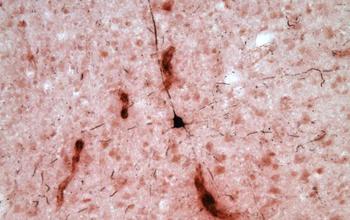Multimedia Gallery
Tau black tangles and amyloid beta in the brain of a 57-year-old chimpanzee.
Tau black tangles and amyloid beta in the brain of a 57-year-old chimpanzee. The co-occurrence of these two proteins is a hallmark of Alzheimer's disease in humans. The tau-positive neuron in the center (black) is at the pretangle/tangle stage. The amyloid beta deposits are present in nearby blood vessels (red).
Credit: Mary Ann Raghanti, Kent State University
Images credited to the National Science Foundation, a federal agency, are in the public domain. The images were created by employees of the United States Government as part of their official duties or prepared by contractors as "works for hire" for NSF. You may freely use NSF-credited images and, at your discretion, credit NSF with a "Courtesy: National Science Foundation" notation.
Additional information about general usage can be found in Conditions.
Also Available:
Download the high-resolution JPG version of the image. (252.5 KB)
Use your mouse to right-click (Mac users may need to Ctrl-click) the link above and choose the option that will save the file or target to your computer.
Related story: New research detects Alzheimer's disease markers in nonhuman primates



